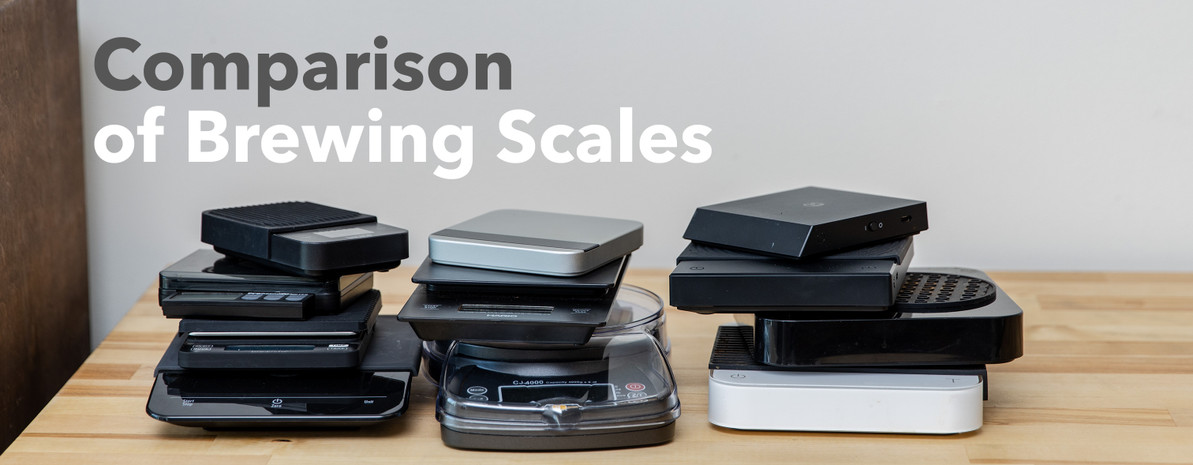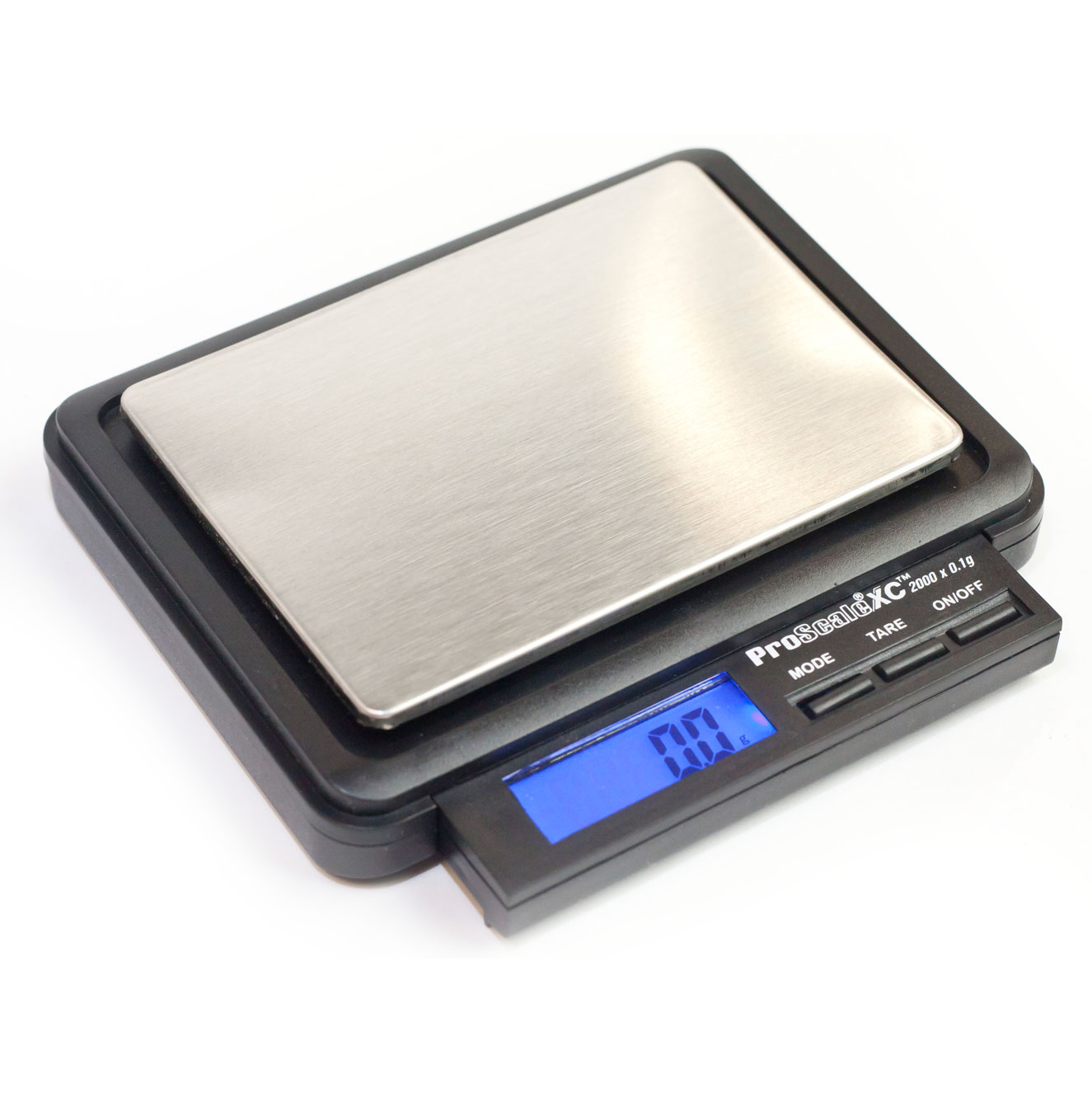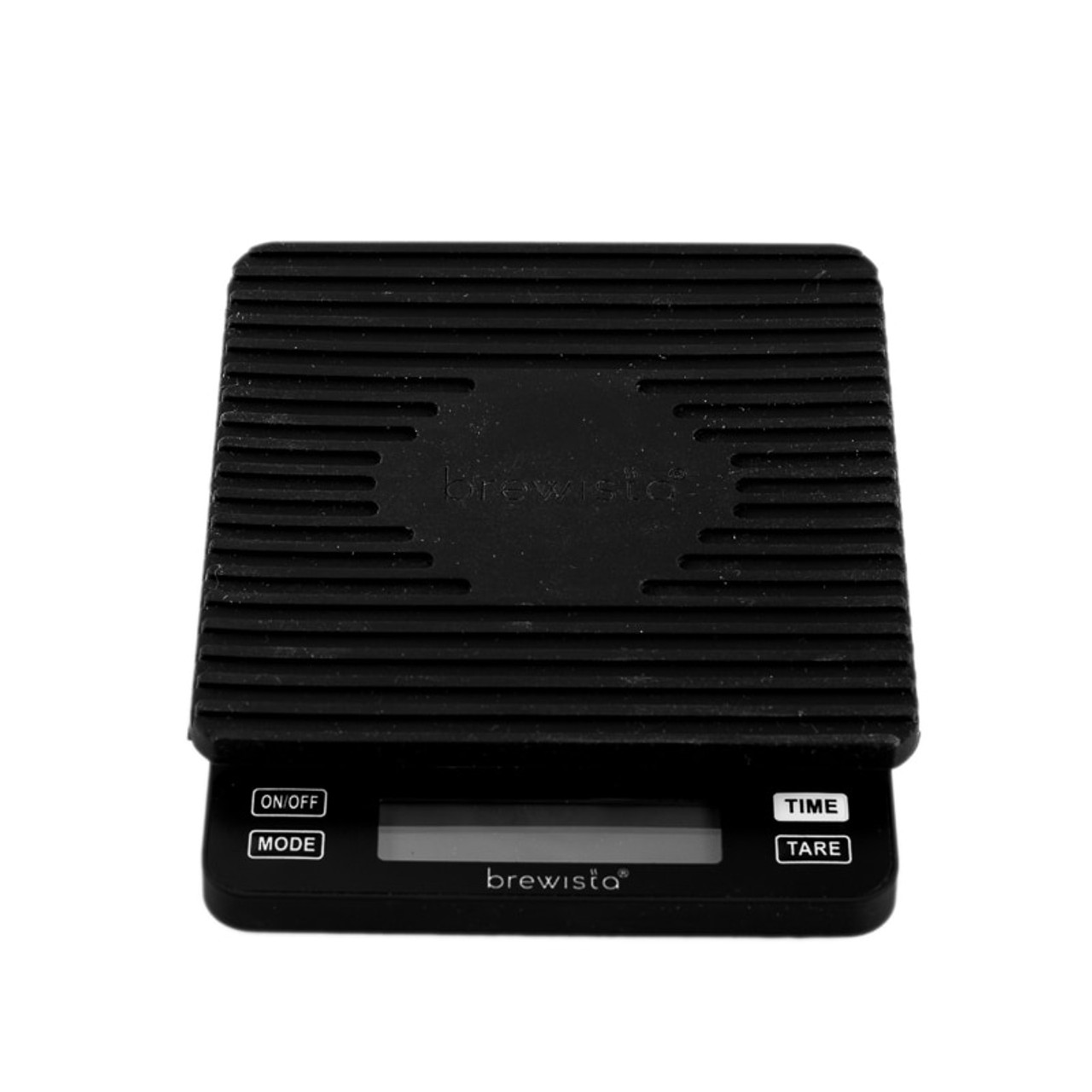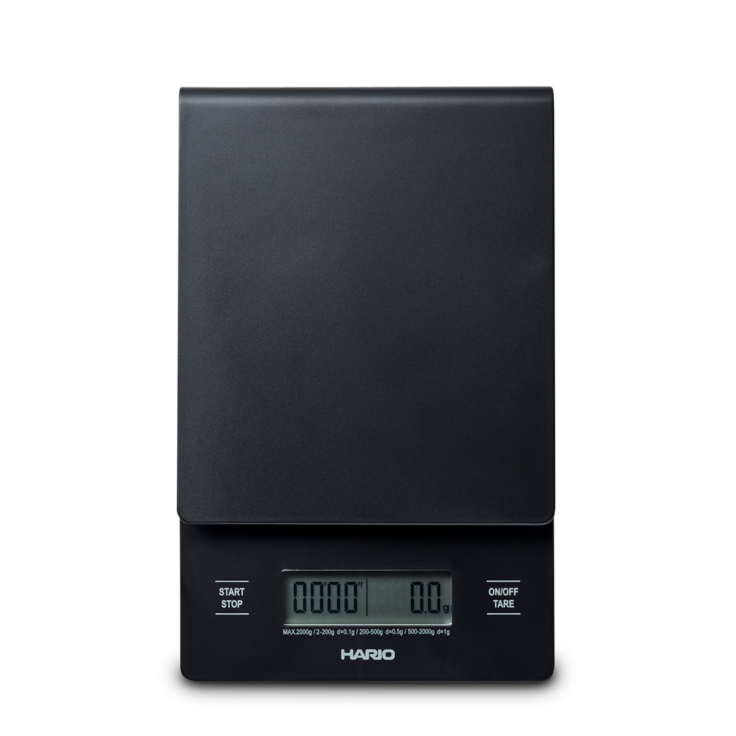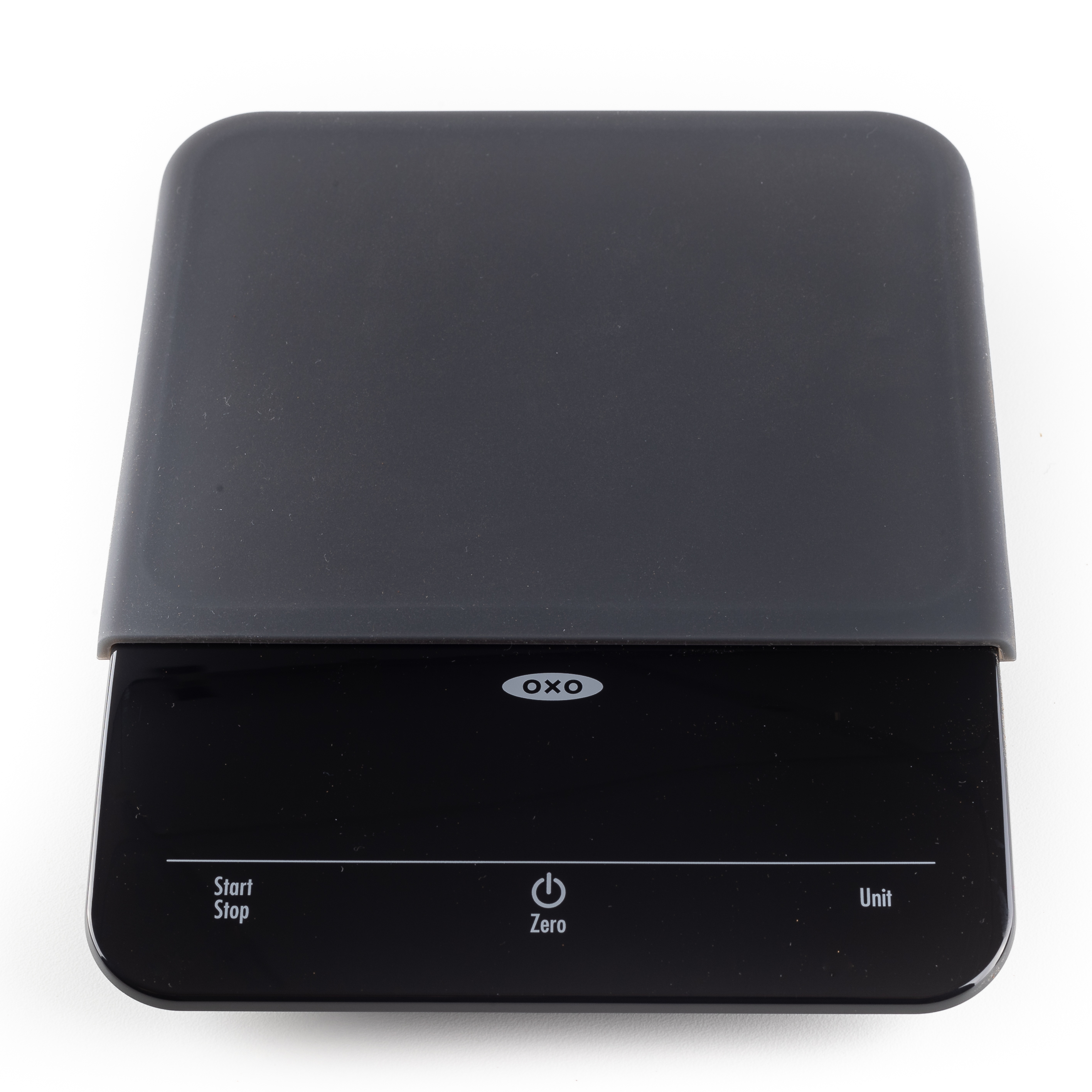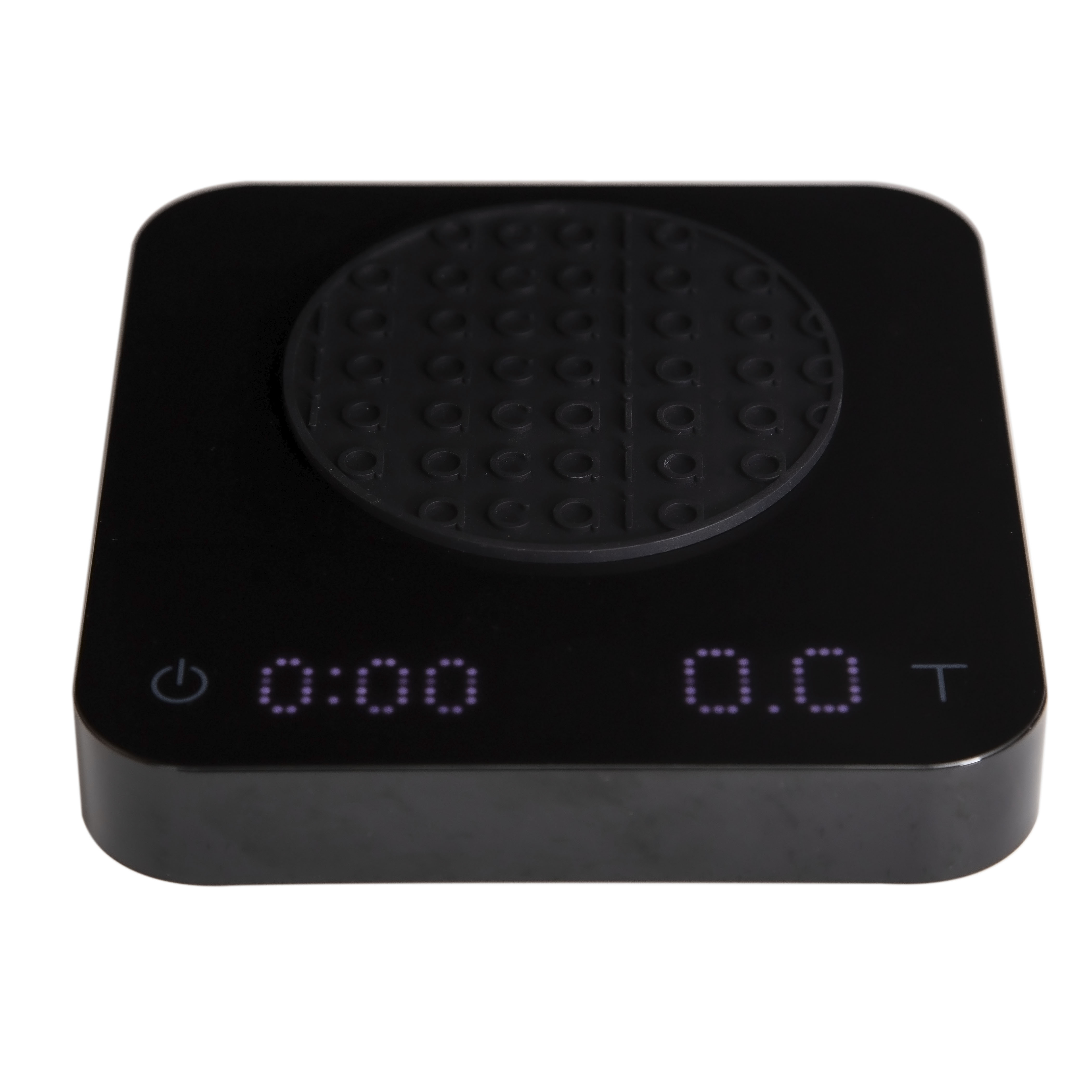A Comparison of Brewing Scales
To the uninitiated, the new-to-coffee person, seeing a barista use a scale to brew coffee is like watching your best friend’s dad get out a yardstick to measure the distance between his golf ball and the first hole at Pappy’s Putt-Putt for Kids. It seems superfluous, and sometimes pretentious.
But the reality is that the benefits of using a scale far outweigh the associations someone might make between you and any overzealous recreational putt-putter. Measuring by weight offers precision and consistency, which are two key components of coffee brewing.
Precision. Weight is far more accurate than volume. If you were to measure out one cup of coffee beans, for example, you would not get exactly one cup of grounds. The empty space that was once between and within the whole beans is nearly erased after grinding, especially on the finer settings, so the post-ground volume will be lower than the pre-ground volume. The weight, however, will remain the same. In other words, looks are deceiving.
Consistency. Have you ever had a cup of coffee and thought, Wow, that’s great, I want to drink this every morning? With the help of a scale, you can. A scale allows you to use the same amount of water and the same amount of coffee for every brew. Once you’ve dialed in a particular coffee, then, you can recreate it daily until it’s time to buy a new bag.
Whether you are making coffee with a manual brewer or with an espresso machine, there are a number of scales on the market for you. Here’s a look at our favorites.
The Scales
ESPRESSO SCALES
Wacaco Exagram Espresso Scale
The Wacaco Exagram Scale has helped fill the gap in the home espresso scale market. While many espresso scales carry a steep price tag, the Exagram scale offers affordability and and convenience making it a great addition to any home barista's home setup. Its most notebale feature is likely its small, compact size of only 3 inches in diameter. This slim profile makes it the perfect size to fit under manual espresso makers like the Flair 58 and Cafelat Robot which have previously lacked an affordable scale for precise and consistent espresso shots.
It has all of the features that are desired in an espresso scale without the extra bells and whistles like modes and apps. It has a max capacity of 2000 kilograms and weighs in increments of 0.1 grams for generous percision. It also comes equipped with an inegrated timer and is capable of weighing in both grams and ounces. Additionally, it comes outfitted with a silicone heat cover to protect it from spills and excessive heat and its small size also make it fantastic for traveling alongside your espresso setup.
- Compact size, excellent for manual espresso makers
- Integrated timer
- Weighs in increments of 0.1g.
- Comes with silicone heat cover
- Affordable espresso scale option
- Finicky on\off function
- Inconvenient on\off button on bottom
- Loud beeping
ProScale XC2000
The ProScale, with its retractable control panel, modest footprint (4.5” x 3.5”), and lightweight body, is a good option for the home or traveling barista. It has a 2kg (2,000g) max capacity and weighs in increments of 0.1g. And although it is sensitive enough to weigh individual coffee beans, it has a relatively slow response time of about 2 seconds. The ProScale is powered by 2 AAA batteries and has a 30-second auto-off function that cannot be disabled. In addition to grams, ounces, and pounds, it weighs in grains, carats, pennyweight, and troy ounces. So, if you plan to weigh other things besides coffee, like your stacks of gold or bags of diamonds, this will work splendidly.
The ProScale can work as an espresso scale, but the reading lags behind the true measurement, so it is necessary to cut off the water about 3-4 grams before it hits the target weight (about 2 grams earlier than the Lunar). For a 40g espresso, for instance, the water should be cut off at about 36g. One caveat, though, is that the ProScale is not waterproof, and, due to its design, appears to catch liquids that fall off the weighing platform. However, in the end, the ProScale makes a great espresso scale at a price that doesn’t hurt much.
As a pour over scale, it functions much better with single-cup drip brewers or an AeroPress than with larger brewers, like a Chemex, which can cover the control panel or slide off the back of the scale. Nevertheless, this would make a great travel scale, perfect for backpacking, taking back and forth between home and the office, or the businessperson who spends a lot of time on the road.
- Compact size, excellent for espresso or travel.
- Pop-out control panel.
- Weighs in increments of 0.1g.
- Sensitive enough to weigh 1 coffee bean.
- Fits on most espresso machine drip trays.
- 30 second auto-off function cannot be disabled.
- Slowest response time.
- Design seems to catch spilled liquids and does not accommodate large manual brewers.
- Not waterproof.
Brewista Smart Scale II
A minor update to the original, the Smart Scale II has a 2kg (2,000g) max capacity, 0.1g resolution, the ability to measure in grams or ounces, a rechargeable battery, auto shut-off, 6 modes of operation, and a water-resistant nano coating.
Although most of the modes are for espresso and it is sized for the drip tray of an espresso machine, the Smart Scale II will work for brewing, too. In fact, the final mode is specific to brewing. The first mode is manual and the other four are dedicated to espresso, including two that automatically tare and time (one that starts the timer at zero and another that starts at first drop); one that automatically tares but requires manual time control; and one that automatically tares but does away with the timer altogether. For the final mode, the timer starts automatically when the first drop of coffee hits the bottom of the vessel. Because the display juts a bit from the body, the buttons are accessible and the numbers are legible even with a vessel as large as a Chemex on the scale. While not as durable as the Lunar, which has a two year warranty on water damage, the Smart Scale is a well-priced competitor with some features, such as the heat-resistant silicone pad and silicone plug over the charging port, that make it practical for damp days on the drip tray.
- Six Modes.
- Scale sensitivity of 0.1g.
- Auto shut-off function.
- Built-in rechargeable battery.
- Includes heat-proof silicone pad.
- Weighs in grams or ounces.
- Water resistant.
- Not waterproof.
- Weighing starts above 1g.
- Tare slightly delayed.
Timemore Black Mirror Nano Coffee and Espresso Scale
Timemore's products offer sophisticated features normally found only on products with higher price tags, and the Nano scale is no exception. For starters, it has everything needed in an espresso scale: a small frame (just 4.5 x 4 inches) , 0.1 resolution, 2kg max load, silicone pad, and a long-lasting battery. But that's not all; it has more: a durable aluminum body, bright LED display, two automatic timing/weighing modes, and, absent on all scales below $100 except this one, a flow rate mode. The latter, which is best used for pour over brewing, is helpful practice for new brewers or anyone looking to increase consistency from brew to shining brew. Also useful for brewing, as opposed to espresso, is the clever angled display, which allows the readings to be visible regardless of the size of the vessel on the platform, meaning this small scale can be used with brewers as large as the 10-cup Chemex. The Nano's rechargeable lithium ion battery will last an estimated 15 hours per charge.
- Espresso and pour over modes.
- Scale sensitivity of 0.1g.
- Flow rate tracking.
- Rechargeable battery (USB-C).
- Bright LED display.
- Long-lasting battery.
- Not waterproof or technically water resistant (because of exposed buttons).
- Buttons on side, not on front or top.
- Switching between modes takes practice.
Acaia Lunar
Like the Pearl, the Lunar has a 2kg (2,000g) max capacity, an ultra-fast response time, the ability to measure in grams or ounces, 0.1g increments, a built-in timer, a rechargeable battery, an adjustable auto-off timer (5, 10, 20, 30, 60, off), touch-sensitive controls, 6 modes of operation, Bluetooth 4.0 capabilities, and enhanced features alongside companion apps.
Unlike the Pearl, however, the Lunar features an anodized aluminum body that is completely waterproof. In fact, you can completely submerge this scale under water, dry it off, and return it to use without harm. Moreover, Acaia’s two year warranty covers liquid damage.
The Lunar also differs from the Pearl and other brew-specific scales in that it offers different modes that are more tailored to making espresso. You can change between these modes by using a long hold on the power button. These modes include: Weight only, Weight and Timer, Auto Start Droplet (starts and stops when scale detects water flow), Auto Start Triangle (scale auto-tares after a stable weight is added, then timer starts), and Auto Start Square (auto-tare of stable weight added to scale).
Thus, Acaia has taken all of the amazing things about the Pearl and shrunken it down into a smaller scale with a few more benefits, making the Lunar a near-flawless scale for making espresso. It truly is an ideal scale for the quality-focused café or the home espresso-making enthusiast, situations where precision is central, multifunctionality is desired, and durability is important.
- Attractive, modern-minimalist design.
- Incredibly fast response time.
- Scale sensitivity of 0.1g all the way up to max capacity.
- Adjustable auto-off function (5, 10, 20, 30, 60, off).
- Built-in, rechargeable battery (20 hour battery life).
- Acaia Apps and Bluetooth capabilities allow an enhanced brewing experience.
- Includes protective feet, 100g calibration weight, and a heat-proof silicone pad that can hold a portafilter.
- 2 year warranty covers liquid damage.
- Expensive.
- A larger learning curve than for other scales.
COFFEE SCALES
Jennings CJ4000
The Jennings Scale is one that can be found in a number of coffee shops and kitchens. It offers nice functionality at a fantastic price point. It has a max capacity of 4kg (4,000g) and can easily switch between weighing in grams, ounces, pounds, or even pieces. It measures in 0.5g increments and has a moderately fast response time, though it can feel a bit laggy (264g mug took about 1 second), making it a satisfactory scale for manual brewing. The CJ4000 has a 2-minute auto-off function, which can be disabled, and is powered either by 3 AAA batteries or an included AC adapter. It also comes with a plastic cover that functions as a multi-use bowl, capable of holding a portafilter or other items larger than the scale’s weighing platform.
The Jennings CJ4000 is a great bang-for-the-buck (or maybe bounce-for-the-ounce?) scale, perfect for manual brewing on a limited budget. The 0.5g increment measurement makes it a little less espresso-worthy than other scales on this list, but its large capacity (4,000g) makes it suitable for small Fetco batches or pour-over brews.
- Superb introductory price.
- Auto-off function can be disabled.
- Powered by AAA batteries or the included AC adapter.
- 20 year warranty.
- 0.5g increments (not a huge issue for manual brewing, but not ideal for weighing espresso doses).
- Bulky and uninteresting aesthetic.
- Not sensitive enough to pick up 1 coffee bean.
Hario Drip
Hario, known for their V60, Buono Kettles, and coffee siphons, offers an equally reputable scale. Designed specifically for the specialty coffee community, the Hario Drip Scale brings together both a gram scale and a built-in timer, two things that are essential when brewing manually. It has a 2000g max capacity and varying scale intervals, depending on weight, of 0.1g (2~200g), 0.5g (200~500g), and 1.0g (500~2000g).While the Hario Drip has a slightly somewhat slow response time (264g mug took about 1.5 seconds), its built-in timer, ease of use, and improved aesthetic make this a favorite to many. It is powered by 2 AAA batteries and has a 5 minute auto-off feature, unless the timer is started, which then extends the feature to 99:59.
Brewing coffee manually requires both a scale and a timer, and The Hario Drip Scale is both of those things in one, at a reasonable price, making this a great scale for daily manual brewing without breaking the bank. On top of this, Hario also makes a V60 Drip Station, which adds stability and class to your brewing routine.
- Built-in timer.
- Easy to use, with touch-sensitive buttons.
- Scale sensitivity is fantastic after 2 grams.
- 5 minute auto-off feature extends to 99:59 when timer is being used.
- Varying increments, depending on weight—0.1g (2~200g), 0.5g (200~500g), and 1.0g (500~2000g).
- Even when a portafilter is tared out, the scale will not weigh in 0.1g increments.
- Only measures in grams.
- Scale does not start weighing until 2 grams are added.
OXO Precision Scale
With the 6-lb Precision, OXO has made a scale comparable to the Hario Drip scale, a fact reflected down to the price. The main difference here is that OXO is not often associated with specialty coffee. That said, OXO has included the two musts for a manual brewing scale: measurement down to the tenth of a gram and a built-in timer. The Precision measures in grams (up to 3kg / 3,000g), pounds, or ounces, and the timer reaches to 9 minutes, 59 seconds.
The extras include two battery-saving features—a sleep mode that engages after 3 minutes of inactivity and an auto shut-off that engages after 30—and a meter that shows how close any load is to the max. The included smooth silicone pad protects the surface of the scale from heat and scratches. The scale is not waterproof, but its unique design—a sloping face and narrow moat around the battery case—move water effectively away from the important internals.
- Built-in timer.
- Easy to use, with touch-sensitive buttons.
- Simple interface with timer and weight.
- Battery-saving features (Auto shut-off at 30 minutes and standby mode at 5 minutes of inactivity).
- Mostly plastic parts.
- Scratches easily.
- Does not have a rechargeable battery (uses 4 AAA batteries).
- Not waterproof.
Timemore Black Mirror Basic Plus Scale
Timemore makes beautiful, modern coffee products and the Black Mirror Basic Plus Scale is no exception. In fact, the “basic” here refers both to the features, which are few but well chosen, and the aesthetic, which is clean and modern. When turned off, the scale is just a black matte block with a small white Timemore logo. No buttons or icons are visible, not even the power button. Once powered on, though, the two features—time and weight—light up along with their small icons. The operation is simple, too. The power button powers up and off but also functions to tare; and the time button starts and stops the time but also functions to toggle the sound. The unseen features include the auto-off, which engages after 3 minutes of total inactivity or 15 minutes of inactivity when the timer is running.
The Black Mirror has everything required for a coffee scale—accuracy to 0.1 gram, a 2-kilo capacity, incredibly quick readings, a silicone heat pad, and a built-in timer—but nothing more, nothing extra to get in the way. It is unfortunately a bit too large for most drip trays but is perfectly sized (and comes with a necessary silicone pad) for weighing the portafilter, so it can be used for pour over or to aid espresso service.
Unlike the Hario and OXO scales on this list, the Black Mirror Plus scale has a rechargeable lithium ion battery and is mostly water resistant but for its open USB-C charging port. Unlike the Pearl and Pearl Model S on this list, the Black Mirror has only one weighing mode. The price tag rightly suggests that it sits somewhere between the Acaias and the Hario and OXO.
- Clean minimalist design.
- Auto-off function.
- Perfectly sized to weigh portafilters (with silicone mat).
- Only one brewing mode.
- Does not fit on most standard drip trays.
- Exposed USB-C port is vulnerable to water.
Acaia Pearl
Acaia scales have quickly become an industry favorite, offering unparalleled functionality and an elegant, minimalist design. The Pearl is Acaia’s manual brewing scale, featuring a larger weighing platform that’s perfect for any brewing device. Alongside its touch-sensitive controls, built-in timer, adjustable auto-off function (5, 10, 20, 30, 60 min or off), spill-resistant outer shell, included silicone heat pad, and 2000g max capacity (70.54oz), the Pearl features a 0.1g sensitivity, an unmatched response time, Bluetooth 4.0 capabilities, and 6 different modes of operation. And if that weren’t enough, it also features an internal, rechargeable battery that lasts 25 hours per charge (using a common micro-USB cable, charging only takes 1~2 hours). Although the Pearl can be used while charging, accuracy is reduced, being only precise to the whole gram.
What sets the Acaia apart from other scales is its capability to change weighing modes. There are six modes that you can use simply by using a long hold on the power button. These modes include: Weight only, Espresso, Weight and Timer, Auto Start, Beverage, and Auto Tare. So, for example, if you are using the Auto Start mode, the scale will display a timer up to 9:99 and weight in grams, and after zeroing out the brewing materials, the timer digits will flash and automatically start once the user begins pouring.
While all of those features are remarkable, the Pearl shines even brighter when used alongside one of its Acaia companion apps (available on both iOS and Android platforms). These apps allow you to log brewing parameters, share pictures and recipes, adjust scale settings, view detailed graphs with visible reference to your pour rate, and even stay up to date with the latest firmware.
The Acaia Pearl is perfect for the coffee enthusiast, the person who loves to nerd-out over manually brewed coffee, as well as the café with a brew bar, one where precision and craft are of utmost importance.
- Beautiful, modern, minimalist design.
- Incredibly fast response time.
- Scale sensitivity of 0.1g all the way up to max capacity.
- Adjustable auto-off function (5, 10, 20, 30, 60, off).
- Built-in, rechargeable battery (25-hour battery life).
- Acaia Apps and Bluetooth capabilities allow an enhanced brewing experience.
- Includes silicone heat pad that doubles as a portafilter leveler.
- More expensive than most other brewing scales on this list.
- A larger learning curve than for other scales.
Acaia Pearl Model S
The Pearl Model S looks like but should not be confused with its predecessor, the Acaia Pearl. This newer model has a larger capacity (3kg/3,000g), a brighter dot-matrix display, a more robust battery (with 15 more hours of life per charge), and—the most notable feature for home baristas—a library of Brewguides available through the new app that make great coffee much more accessible. From the app, you can search recipes or create your own; you can share recipes with others, too, or simply send your favorites directly to the scale. You can also customize your scale’s features in the app, enabling or disabling brewing modes, setting the screen brightness and auto-off timer, setting your desired display units, and creating your own welcome message. This scale can be a little daunting at first because it includes so many extras, but once you get the hang of it, the S will easily become your favorite brewing buddy.
The S also includes other nerdy features, such as the flow rate practice mode, which displays both the flow rate in grams/second and a visual graph of the flow rate, allowing you to perfect your pour, and 7 modes: the aforementioned Brewguide and flow rate modes in addition to weight, timer, portafilter, and espresso functions.
If you love the Acaia Pearl but desire a more interactive brewing experience and the ability to record your coffee journey, the Model S is for you.
- Beautiful, modern, minimalist design.
- Incredibly fast response time.
- Scale sensitivity of 0.1g all the way up to max capacity.
- Adjustable auto-off function (5, 10, 20, 30, 60, off).
- Built-in, rechargeable battery (40-hour battery life).
- Brewguide app with step-by-step prompting.
- Includes round silicone heat pad.
- More expensive than the original Pearl.
- The interface, because of all the modes and accessible features, can be a little confusing at first.
Conclusion
The next time someone compares you to their best friend’s Dad who loves putt-putt more than life itself, sleep well knowing that the benefits of using a scale far outweigh (pun intended) those lame associations. Brewing with a scale offers improved precision and consistency (and thus repeatability), giving you a much better chance at finding and maintaining each coffee’s sweet spot.
While there are a number of things to consider when brewing coffee (like your grinder, your kettle, your espresso machine, and your water), a scale is an important piece of the puzzle, and we think that these are the best out there. If you need help finding the best one for you, give us a call or send us a message. We love to talk scales.
